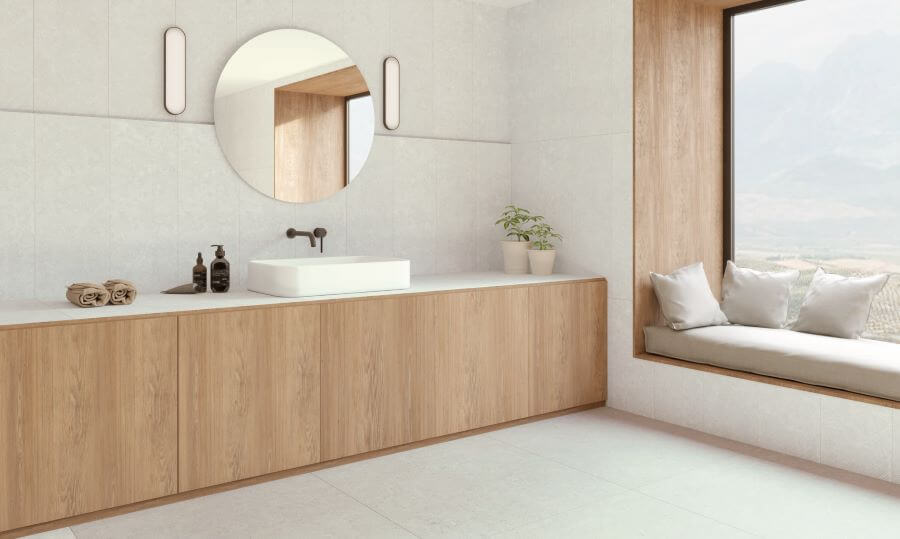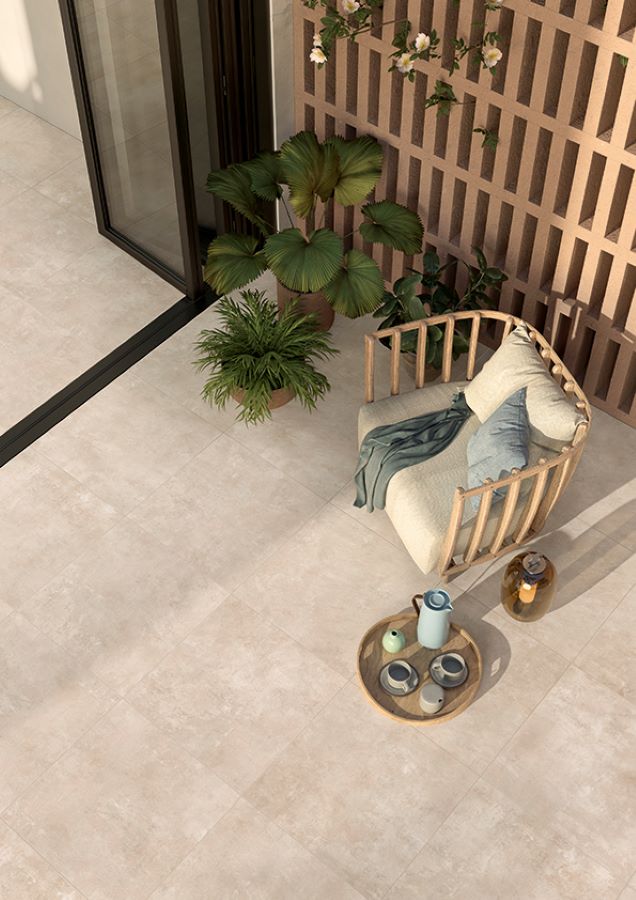
It’s a good question. Should you tile all the walls in a bathroom? Whilst there isn’t a specific answer in this instance, there are pros and cons to consider for tiling your entire bathroom. As bathroom design moves beyond just the functional, we are creating spaces that have that spa like vibe and a touch of the luxurious. Ceramic and porcelain tiles play an important part in this not only from a practical perspective, but they can truly elevate a design. It isn’t just the design of tiles that play a part, it is also tile finishes. The latest tile textures are perfect for creating warm, welcoming spaces with matt and textured finishes and warm neutral colours bringing a cosy vibe to this smallest of rooms.
So, let’s take a look at some of the pros and cons for tiling all the walls in your bathroom.
At the very least tiles are a perfect pick for areas where water is likely to splash on walls. Correct installation is, of course, key, but ceramic and porcelain tiles are highly water resistant, and this ensures your walls are protected from water ingress. So, some well-chosen tiles around the bath, in the shower, near the WC or around the basin are pretty essential. At the other end of the spectrum you have the option to tile your entire space – not just from a practical perspective either – perhaps you want to create the wow factor.
Durability
Bathrooms really can take a bit of a battering. Especially family bathrooms! These can be busy spaces so opting for a material like porcelain or ceramic tiles protects walls against marks, scuffs and damage. Tiles are highly scratch and stain resistant and don’t tend to show signs of wear and tear and they will last for many years.
Water Resistance
Bathrooms tend to be small. In addition, they are pretty humid spaces with water sloshing around and lots of steam on occasions. Porcelain tiles in particular are highly water resistant – so much so they can even be used outside for patios in the right antislip finishes. Tiling walls as well as floors creates a waterproof barrier and this makes your room easier to clean as well as protecting walls.
Ease of cleaning
Tiles are a cinch to keep clean. Unlike paint or wallpaper, they wipe down easily with a cloth and warm water and you can buff them up with a dry cloth if needed. Rectified tiles in particular ie tiles with straight edges mean grout lines are at a super slim 3mm so at a minimum. In addition, tile formats have steadily increased so that larger tiles have become the go-to for many projects. Even for smaller bathrooms it can worth considering bigger tiles because larger tiles mean there are less grout lines. Using a good quality grout protector spray will help make cleaning easy too!
Design
You really can’t beat a beautifully well-designed Italian or Spanish porcelain or ceramic tile. Tile design, driven by leading manufacturers has risen to incredible heights over the past few years with porcelain tiles in particular re-interpreting all kinds of materials from marbles to stones, woods to concretes, cements to metallics – and with incredible precision. The beauty here is you have all that gorgeous design coupled with the amazing practicality of porcelain so unlike natural stone there is no sealing or ongoing maintenance required with porcelain and unlike real wood porcelain won’t bend or warp with moisture.
The luxury look and feel
Tiling floor to ceiling can give your bathroom a really high-end look echoing that spa like feel. That’s partly because it creates a seamless appearance particularly if using large format tiles for a “more tile, less grout look”. Large format marble effect porcelain tiles in particular, such as our Macchia Vecchia collection, will elevate your space, but it is also worth considering the more muted tones in concretes and cements – check out our Docklands collection – especially those with a soft matt finish if you are looking for a contemporary look and feel.
Porcelain tiles are incredibly hardwearing. They are made from a mix of minerals and clays and fired at higher temperatures than ceramic tiles, so they are perfect for floors. They are also great for walls; however, ceramic tiles are lighter than porcelain tiles and they are also easier to cut. So if you are thinking of tiling all walls, opting for a porcelain tile for the floor with a co-ordinating tile in ceramic for the walls can be a really great solution – this is especially the case in smaller bathrooms where your tiler is perhaps having to cut around pipes etc. Ceramics are easier to work with. Check out our Docklands collection with porcelain tiles for the floor and co-ordinating ceramic tiles for the walls.
Tiling all the walls in a bathroom does have some cost implications. Not only in terms of the tile cost, there is also installation to consider, however you will still need to finish bathroom walls by painting and whilst the tiled area will need little maintenance over the years, you may find you need to repaint areas.
Texture. It is a key consideration. Tiles in glossy or polished finishes can make spaces feel a little cold because they reflect light. So, thinking carefully about the texture of your chosen tile is key. Matt or Soft finish tiles absorb more light, and this can make spaces feel much cosier.
Remember you can tile all the walls in a bathroom but you don’t have to tile all walls floor to ceiling. It doesn’t have to be an either or situation. You may decide to tile every wall to half height – with the exception of shower areas of course. For a typical 2.4m ceiling height tiling to a height of 1.2m can work well.
You may want to create a feature wall – one that brings the wow factor to your space – whether that’s behind the bath, the vanity basin or in the shower. Feature tiles can create a focal point and add a stamp of personality to bathrooms.
Large format tiles can make a small bathroom feel more spacious because there are less grout lines – and grout lines tend to make spaces feel busier. However, always check the suitability of your chosen tiles with your tiler before committing to a particular tile.
So, should you tile all the walls in a bathroom? Well, if it’s durability and ease of cleaning you are seeking then tiling floor to ceiling and every wall is a great option. It also really does give your bathroom a premium look and feel. However, if budget is key, or your space is particularly small it may be better to consider opting for a combination of tile and other options or even picking a porcelain tile for the floor and ceramic tile for the walls. What is key is making sure you always speak with your tiler before finally plumping for a tile!
Click the images with a description underneath to head straight to these tiles on our website. Working on a project? We’d love to help! Get in touch and let us start searching for beautiful tiles with you!
If you would like to know more, please get in touch...
The TilePortfolio specialise in Italian and Spanish Porcelain and Ceramic tiles, in particular large format Porcelains and Porcelain tiles for inside and outside. Our carefully curated, stunning tile portfolios are beautifully presented online and supported by our fuss-free ‘go-the-extra-tile’ service. In addition, you can view our entire tile collection at our Northamptonshire Showroom. Visit our website for unmissable interiors inspiration. The TilePortfolio team are always available to chat, we’d be delighted to help with your project so please do get in touch.
Please note: We strongly recommend using a professional tiler for your project. Installation requirements may vary depending on the tiles you choose, the fixing products used and the specific conditions. Always check with your tiler regards the suitability of the tiles. Please get in touch with us if you have any questions.
